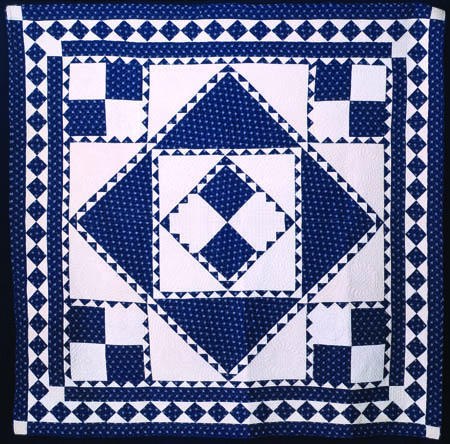
The International Quilt Study Center and Museum will present the exhibition ‘Indigo Gives America the Blues’ from Sept. 7 through June 2, 2013. The exhibition features 13 quilts ranging from the early 1800s to the 1980s that illustrate the history of indigo dyeing in the United States. Also featured are a range of antique fabric samples, woven coverlets, and doll and crib quilts that display the versatility of indigo dye in American textiles.
In "Indigo Gives America the Blues," Indigo dramatically changed the appearance of European and American textiles after it was first introduced, giving a range of colorfast blues to fabrics used in all sorts of household furnishings, including quilts. It continues to influence textile fashions today, as evidenced by its use in an American icon – blue jeans. ‘Indigo Gives America the Blues’ traces the history of indigo dyeing and brings one of America’s favorite colors to life.
Indigo, with its distinctive blue color, is one of the oldest dyes used for textile dyeing and printing. A variety of plants in the indigofera family have been used for centuries in many parts of the world including Africa, Asia and Central and South America. Its range of long-lasting colors—from light sky blue to deep navy blue—made indigo hugely popular and highly valued when it was first imported from India to the western world in the late 1400s and early 1500s, resulting in the nickname “Blue Gold.” However, Europe, the British Isles and North America did not have this superior dyestuff in great quantities until exotic commodities began to be imported by the East India Companies in the early 1600s. Today, synthetic indigo colors more than one billion pairs of jeans; no other dye can produce the special appearance we expect of blue denim.
Indigo proves challenging as a dye because it is not soluble (dissolvable) in water. It must be chemically modified to make it water soluble and the moment a submerged fabric is removed from the indigo dyebath and exposed to air, the dye oxidizes and returns to its insoluble form. Because of this distinctive characteristic, European dyers and printers struggled with the temperamental dye when it became widely available in Europe. They continued to search for improved dyeing and printing techniques well into the 1800s.
"Indigo Gives America the Blues" presents a range of quilts showing several of the techniques devised by textile printers to deal with this difficult dye. For instance, a circa 1820-1840 Whole Cloth quilt with a Flying Geese border is an excellent example of what is sometimes called “American Indigo Resist.” This fabric type is distinct in that it presents large blue motifs on a white background, as opposed to the more usual small white motifs on a blue ground. This distinctive appearance was derived through the use of a “resist,” a chemical paste that, once it was applied to the design areas of the fabric, would block the penetration of dye. All surviving examples of this fabric type have been found in the United States (although pattern books with similar designs have been found in the United Kingdom), thus the name, “American Indigo Resist.”
Another quilt in the exhibition features fabrics from around the time dyers replaced the natural, plant-derived version of indigo dye with a synthetic version. Indigo was first synthesized in Germany and became commercially available in 1897. Synthetic indigo almost completely superseded natural indigo by 1913. The exhibition’s circa 1890-1910 Delectable Mountains quilt shows a range of small scale white on blue prints typical of the period, which could have been achieved with either natural or synthetic indigo. It is virtually impossible to tell the difference between the two with the naked eye.
A final example from the exhibition is what is sometimes called a “Britchy” quilt because it is made from recycled blue jeans (or “britches”). This one was made around 1980 by Maggie Smith of Greene County, Alabama. Where the back pockets have been removed, you can see the original color of the denim, a deep blue that has now faded dramatically in the rest of the fabric.
Support for this exhibition is provided by the Nebraska Arts Council, the Nebraska Cultural Endowment, and the Friends of the International Quilt Study Center and Museum.
For information on this and other programs, log on to http://www.quiltstudy.org.